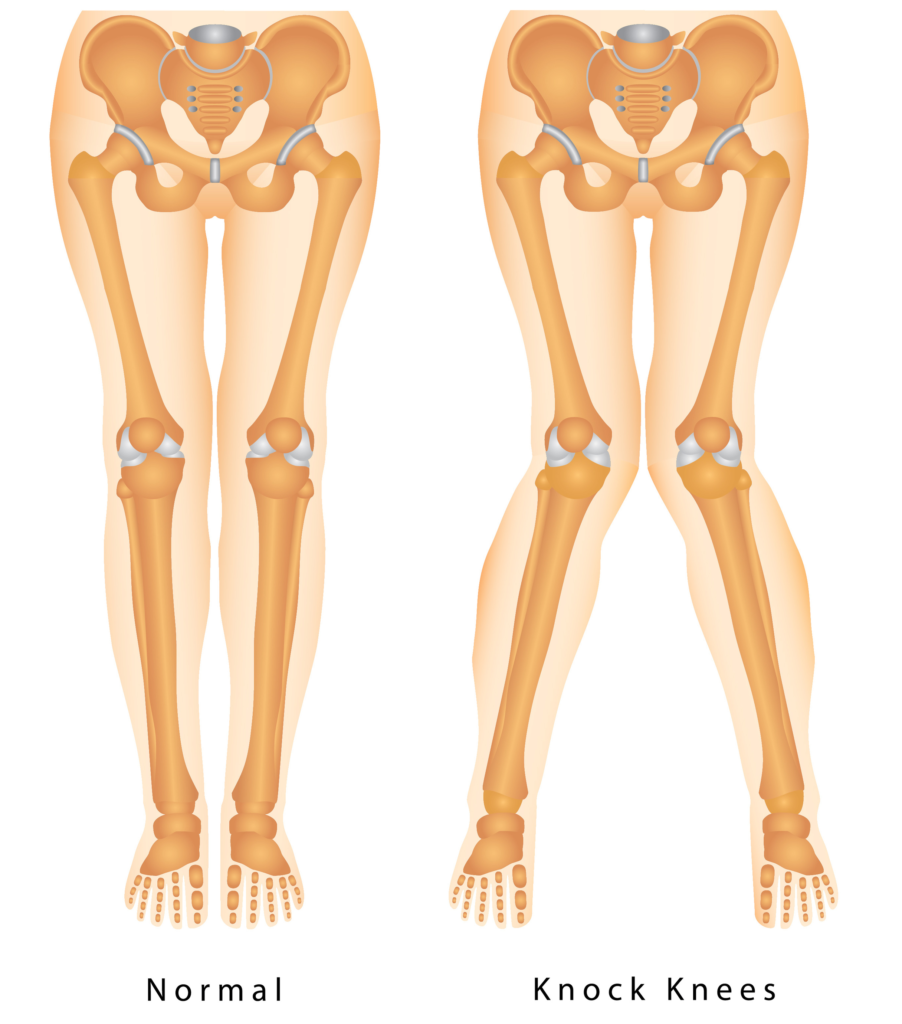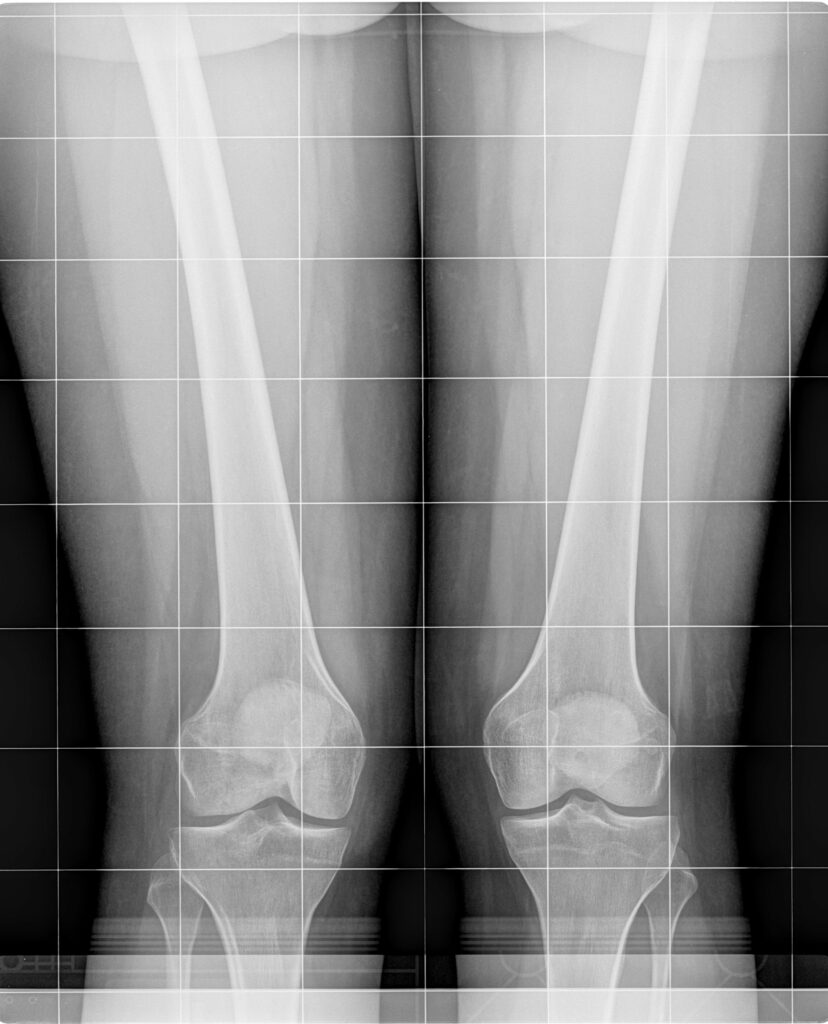Knock knees, also known as Genu Valgum, is a condition in which a person’s knees appear to angle inward and touch when their legs are straightened.
Understanding knock knees is important for individuals who experience this condition.
While it is most commonly seen in children, this condition can also affect adults.
This article will explore the causes, symptoms, diagnosis, and treatment options for knock knees, as well as provide some tips for living with this condition.
Understanding Knock Knees
In Knock knees, the knees bend inwards and sometimes touch each other while the feet are apart.
This results in a distinct space between the feet and ankles.
The alignment of the lower legs is important for the proper distribution of weight and forces across the feet and ankles.
Knock knees can disrupt this alignment and cause problems such as knee and ankle pain and even cause instability.
It can also lead to an increased risk of developing arthritis in the knees especially on the outer aspect of the knee if left unaddressed.
The diagnosis is typically made by a physical examination.
The clinician doctor will measure the intermalleolar distance (distance between the inside of the ankle joints), when the knees are together.
If the distance is greater than normal, then knock knees may be present.
X-rays may also be used to confirm the diagnosis and assess the severity of the condition.
The type of xray is often a long leg weight bearing xray
Treatment for knock knees depends on the severity of the condition and the presence of any associated symptoms.
Often in childhood, no treatment is necessary as the condition will correct itself as the child grows.
However, in cases where knock knees persist into adulthood or cause discomfort, treatment options may include physical therapy, knee braces or surgery.
Causes of Knock Knees
This condition can occur in both children and adults and can be caused by a variety of factors.
In Children
In most cases, knock knees in children are caused by the normal phase of growth and development. As children grow, their legs naturally begin to angle inwards, and this usually corrects itself by the time they reach the age of 7 or 8.
However, in some cases, knock knees can be caused by an underlying problem, such as vitamin D deficiency, which can lead to weakened bones and a condition known as rickets.
It can be useful to have blood tests such as vitamin D levels carried out to exclude abnormal bone growth due to vitamin D deficiency
In Adults
In Adults, knock knees can be caused by a variety of factors, including injuries to the knees or legs, arthritis, and genetic conditions that affect the joints.
For example, joint hypermobility syndrome or Ehlers-Danlos syndromes can cause the joints to be more flexible than normal, which can lead to knock knees.
In some cases, the cause may be excessive pressure on the knees, such as obesity or loose knee ligaments.
Bone diseases resulting from deficiencies in some Vitamins and Minerals can also manifest themselves into adulthood.
It is important to mention factors such as congenital or developmental diseases, metabolic bone disorders, or calcium deficiency.
In these cases, treatment will depend on the underlying cause of the condition.
Symptoms and Diagnosis
Identifying Symptoms.
If the angle of the legs from hip to foot falls outside normal patterns, worsens over time, or is present on only one side of the body, this suggests a person has a more serious form of knock knees.
Symptoms may include pain in the knees, a limp, and difficulty walking.
In severe cases an orthopedic opinion is advised as hip pathology or a more sinister cause must also be excluded
Diagnosis
If a person experiences any of the symptoms associated with knock knees, they should see a clinician.
The patient will have a physical assessment and often the person’s leg lengths and height are assessed to determine if there is an underlying problem causing the condition.
To confirm the diagnosis, the clinician may order an X-ray of the legs and pelvis.
X-rays can help determine the severity of the condition and whether there are any underlying problems, such as bone fractures or growth abnormalities.
In some cases, further evaluation by an orthopedic specialist may be necessary.
If the condition is severe and causing significant pain or difficulty walking, orthotics or knee adjustable off loading knee braces may help but often surgery may be deemed necessary to reduce and treat symptoms.
Complications of Knock Knees
There are a host of complications with this condition including secondary effects on other joints including pain and arthritis over time if left untreated
Often we come across these patients suffering from hip, knee or ankle pain.
Often the hip or ankles are forced to compensate for the misalignment of the knees, with extra strain on the joint, leading to pain and discomfort.
Knee pain from patellofemoral maltracking and instability.
Being overweight can also exacerbate the problem.
The extra body weight can put additional strain on the joints, leading to increased pain and discomfort.
Treatment Options
There are various treatment options available.
The appropriate treatment method depends on the severity of the condition and the age of the patient.
The two main categories of treatment options are non-surgical and surgical treatments.
Non-Surgical Treatments
In most cases, knock knees do not require surgery and can be treated with non-surgical methods.
Non-surgical treatments include exercises, braces, orthotics and weight loss.
Exercises
Exercises aim to help align the knees.
Exercises that can be helpful include squats, lunges, and leg presses.
A physiotherapist can recommend specific exercises that are appropriate for the individual.
Knee Braces
Braces can be used to correct knock knees in children. Braces work by applying pressure to the knees to help straighten them.
The brace is worn for a specific period of time, usually several months, and the child’s progress is monitored by a doctor.
Orthotics
Orthotics can also be used. Orthotics with arch supports and cushioned soles can help improve the alignment of the legs.
Weight Loss
Weight loss can be an effective non-surgical treatment.
A healthy diet and regular exercise can help individuals achieve a healthy weight and reduce the severity of the condition
In severe cases of knock knees, surgery may be necessary to correct the condition.
Frequently Asked Questions
What are the common signs of knock knees?
The most common sign is a visible gap between the ankles when standing with the knees together. This condition is most common in children aged 3 to 6 years and usually improves on its own as they grow without causing any problems. However, in some cases, it can persist into adulthood and cause knee pain, instability, or arthritis.
What causes knock knees in adults?
In adults, a variety of factors, including obesity, osteoarthritis, injury, or a congenital condition. It can also be caused by certain medical conditions such as rickets, Blount’s disease, or cerebral palsy.
Is knock knee a problem?
In most cases, they are not a problem and do not require any treatment.
However, in some cases, they can cause pain, instability, or arthritis, especially in adults. If you are experiencing any symptoms, it is recommended to consult a doctor.
How can knock knees be tested?
By checking the alignment of the legs and knees. investigations can include long leg weight bearing X-rays or other imaging tests to determine the severity of the condition.
Can knock knees be fixed without surgery?
In many cases, they can be helped without surgery through physical therapy, braces, or orthotics.
However, in severe cases, surgery may be necessary to realign the bones and joints.
Are there Injections for Knock Knees?
Certain injections such as hyaluronic acid/Corticosteroids may be used to treat knee pain and degeneration associated with the condition.






